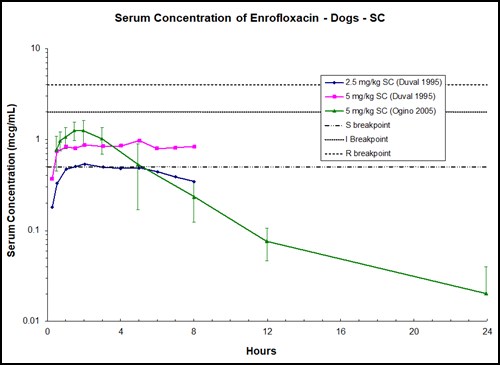

As heterotetramers, these enzymes are composed of two GyrA and two GyrB subunits, in the case of gyrase, or their homologs ParC and ParE in topoisomerase IV. Their activities facilitate the processes of DNA replication, recombination, and gene expression.

The targets of enrofloxacin, like other quinols, are enzymes that control DNA topology: gyrase and topoisomerase IV. Its crucial chemical and physical properties are shown in Table 1. Enrofloxacin is highly lipophilic, and the addition of a carboxylic acid and a tertiary amine contributes to its amphoteric properties. Moreover, this antibiotic is a quinoline monocarboxylic acid, a quinolone, an organofluorine compound, an N-alkyl piperazine, and a member of the cyclopropanes. Ĭhemically, enrofloxacin is defined as a quinoline monocarboxylic acid that is 1,4-dihydroquinoline-3-carboxylic acid substituted by an oxo moiety at position 4, with a fluoro moiety at position 6, a cyclopropyl moiety at position 1, and a 4-ethylpiperazin-1-yl moiety at position 7. Currently, the product is approved by the European Medicines Agency (EMA) in both injectable and tablet forms. This compound is a chemotherapeutic, and it was first synthesized in 1983 from nalidixic acid, while the first enrofloxacin-based medicinal product was marketed in 1991 as an oral drug for poultry by Bayer under the trade name Baytril ®. This antibiotic is widely used in veterinary medicine as an antibacterial agent, showing high activity against both Gram-negative and Gram-positive bacteria. Recommendations for further research on enrofloxacin are also proposed.Įnrofloxacin is an antibiotic that belongs to the fluoroquinolone group, more specifically the 6-fluoro-7-piperazinyl-4-quinolones. Animal health and the environmental effects of this stable antibiotic (with half-life as long as 3–9 years in various natural environments) are analyzed, as are the interesting properties of this molecule that are expressed when present in complexes with metals. In this review article, we present in detail and discuss the advantageous and disadvantageous properties of enrofloxacin, showing the benefits and risks of the use of this compound in veterinary medicine. However, the use of enrofloxacin causes severe adverse effects, including skeletal, reproductive, immune, and digestive disorders. The high efficacy of this molecule has been demonstrated in the treatment of various animals on farms and other locations. It reveals strong antibiotic activity against both Gram-positive and Gram-negative bacteria, mainly due to the inhibition of bacterial gyrase and topoisomerase IV enzymatic actions. Enrofloxacin is a compound that originates from a group of fluoroquinolones that is widely used in veterinary medicine as an antibacterial agent (this antibiotic is not approved for use as a drug in humans).


 0 kommentar(er)
0 kommentar(er)
